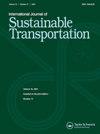Impacts of high-speed rail on household carbon dioxide emissions: Evidence from China
IF 3.1
3区 工程技术
Q2 ENVIRONMENTAL STUDIES
International Journal of Sustainable Transportation
Pub Date : 2025-02-01
DOI:10.1080/15568318.2025.2459614
引用次数: 0
Abstract
This study employs a difference-in-difference (DID) regression to estimate the impact of high-speed rail (HSR) on city-level household carbon dioxide emissions across various consumption categories. The DID analysis is based on a sample of 179 Chinese cities during 2010-2018, and reveals a positive association between HSR and household carbon dioxide emissions. The findings suggest that cities with HSR emit more carbon dioxide due to increased daily consumption, and this effect grows over time. The mechanism analysis shows that the development of HSR stimulates household income growth, leading to increased consumption-based carbon dioxide in cities with HSR. Despite being considered a green transportation mode with a low carbon footprint, this research highlights potential environmental burdens associated with HSR, emphasizing the need for sustainable HSR development and environmental management policies.
高铁对家庭二氧化碳排放的影响:来自中国的证据
本研究采用差分回归(DID)方法估计高铁(HSR)对不同消费类别城市家庭二氧化碳排放的影响。DID分析基于2010-2018年179个中国城市的样本,揭示了高铁与家庭二氧化碳排放之间的正相关关系。研究结果表明,有高铁的城市由于日常消费的增加而排放更多的二氧化碳,而且这种影响随着时间的推移而增加。机制分析表明,高铁的发展刺激了家庭收入的增长,导致高铁城市的消费性二氧化碳增加。尽管高铁被认为是一种低碳足迹的绿色交通方式,但本研究强调了与高铁相关的潜在环境负担,强调了可持续高铁发展和环境管理政策的必要性。
本文章由计算机程序翻译,如有差异,请以英文原文为准。
求助全文
约1分钟内获得全文
求助全文
来源期刊
CiteScore
8.90
自引率
2.60%
发文量
56
期刊介绍:
The International Journal of Sustainable Transportation provides a discussion forum for the exchange of new and innovative ideas on sustainable transportation research in the context of environmental, economical, social, and engineering aspects, as well as current and future interactions of transportation systems and other urban subsystems. The scope includes the examination of overall sustainability of any transportation system, including its infrastructure, vehicle, operation, and maintenance; the integration of social science disciplines, engineering, and information technology with transportation; the understanding of the comparative aspects of different transportation systems from a global perspective; qualitative and quantitative transportation studies; and case studies, surveys, and expository papers in an international or local context. Equal emphasis is placed on the problems of sustainable transportation that are associated with passenger and freight transportation modes in both industrialized and non-industrialized areas. All submitted manuscripts are subject to initial evaluation by the Editors and, if found suitable for further consideration, to peer review by independent, anonymous expert reviewers. All peer review is single-blind. Submissions are made online via ScholarOne Manuscripts.

 求助内容:
求助内容: 应助结果提醒方式:
应助结果提醒方式:


